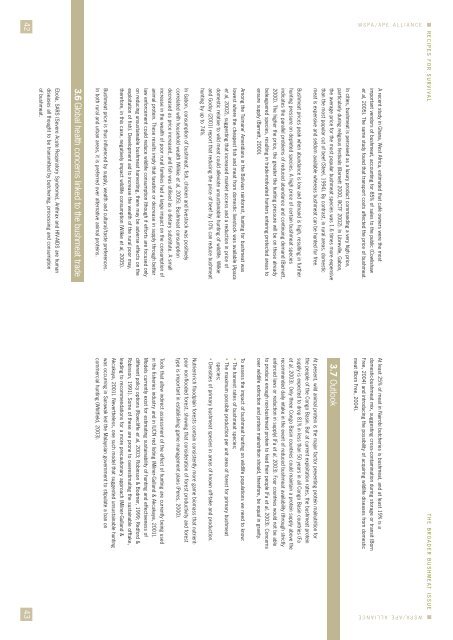Recipes for Survival_English_tcm46-28192
Recipes for Survival_English_tcm46-28192
Recipes for Survival_English_tcm46-28192
- No tags were found...
You also want an ePaper? Increase the reach of your titles
YUMPU automatically turns print PDFs into web optimized ePapers that Google loves.
WSPA/APE ALLIANCERECIPES FOR SURVIVALA recent study in Ghana, West Africa, estimated that café owners were the mostimportant vendors of bushmeat, accounting <strong>for</strong> 85% of sales to the public (Cowlishawet al, 2005). The same study found that transport costs affected the price of bushmeat.In cities, bushmeat is perceived as a luxury product commanding a very high price,particularly during religious festivals (Barnett 2000, BCTF 2002). In Libreville, Gabon,the average price <strong>for</strong> the most popular bushmeat species was 1.6 times more expensivethan the most popular cut of beef (Steel, 1994). By contrast, in rural areas, domesticmeat is expensive and seldom available whereas bushmeat can be hunted <strong>for</strong> free.Bushmeat prices peak when abundance is low and demand is high, resulting in furtherhunting pressure on depleted species. A high price of certain bushmeat speciesindicates the parallel problems of reduced abundance and continuing demand (Barnett,2000). The higher the price, the greater the hunting pressure will be on these alreadybeleaguered species, resulting in trade-motivated hunters entering protected areas toensure supply (Barnett, 2000).Among the Tsimane’ Ameridians in the Bolivian rain<strong>for</strong>est, hunting <strong>for</strong> bushmeat waslowest where the cheapest fish and meat from domestic livestock was available (Apazaet al, 2002), suggesting that increased market access and a reduction in price ofdomestic relative to wild meat could alleviate unsustainable hunting of wildlife. Wilkieand Godoy (2001) report that reducing the price of beef by 10% can reduce bushmeathunting by up to 74%.In Gabon, consumption of bushmeat, fish, chicken and livestock was positivelycorrelated with household wealth (Wilkie et al, 2005). Bushmeat consumptiondecreased as price increased, and fish was utilised as a dietary substitute. A smallincrease in the wealth of poor rural families had a large impact on the consumption ofanimal protein. These results imply that taxation or decrease in supply through betterlaw en<strong>for</strong>cement could reduce wildlife consumption (though if ef<strong>for</strong>ts are focused onlyon reducing unsustainable bushmeat harvesting, there may be adverse effects on theexploitation of fish). Development aid to increase the wealth of the rural poor may,there<strong>for</strong>e, in this case, negatively impact wildlife consumption (Wilkie et al, 2005).Bushmeat price is thus influenced by supply, wealth and cultural/taste preferences.In both rural and urban areas, it is preferred over alternative animal proteins.3.6 Global health concerns linked to the bushmeat tradeEbola, SARS (Severe Acute Respiratory Syndrome), Anthrax and HIV-AIDS are humandiseases all thought to be transmitted by butchering, processing and consumptionof bushmeat.THE BROADER BUSHMEAT ISSUEAt least 25% of meat in Nairobi butcheries is bushmeat, and at least 19% is adomestic-bushmeat mix, suggesting cross-contamination during storage or transit (BornFree, 2004) and introducing the possibility of acquiring wildlife diseases from domesticmeat (Born Free, 2004).3.7 OutlookAt present, wild animal protein is the major factor preventing protein malnutrition <strong>for</strong>the people of the Congo Basin. But at current exploitation rates, the bushmeat proteinsupply is expected to drop 81% in less than 50 years in all Congo Basin countries (Faet al, 2003). Only three Congo Basin countries could maintain a protein supply above therecommended daily intake in the event of reduced bushmeat availability (through strictlyen<strong>for</strong>ced laws or reduction in supply) (Fa et al, 2003). Four countries would not be ableto produce enough non-bushmeat protein to feed their people (Fa et al, 2003). Concernsover wildlife extinction and protein malnutrition should, there<strong>for</strong>e, be equal in gravity.To assess the impact of bushmeat hunting on wildlife populations we need to know:• The harvest rates of bushmeat species;• The maximum possible production per unit area of <strong>for</strong>est <strong>for</strong> primary bushmeatspecies;• Densities of primary bushmeat species in areas of known off-take and production.Nutrient-rich floodplain <strong>for</strong>ests contain consistently more game biomass that nutrientpoornon-flooded <strong>for</strong>est, showing that consideration of <strong>for</strong>est productivity and <strong>for</strong>esttype is important in establishing game management plans (Peres, 2000).Tools that allow indirect assessment of the effect of hunting are currently being usedin the fisheries industry and in IUCN red listing (Milner-Gulland & Akcakaya, 2001).Models currently exist <strong>for</strong> estimating sustainability of hunting and effectiveness ofdifferent policy options (Rowcliffe et al, 2003; Robinson & Bodmer, 1999; Red<strong>for</strong>d &Robinson, 1991). Some of these are prone to overestimating the sustainable offtake,leading to recommendations <strong>for</strong> a more precautionary approach (Milner-Gulland &Akcakaya, 2001). Nevertheless, one such model that suggested unsustainable huntingwas occurring in Sarawak led the Malaysian government to stipulate a ban oncommercial hunting (Whitfield, 2003).43WSPA/APE ALLIANCE42


